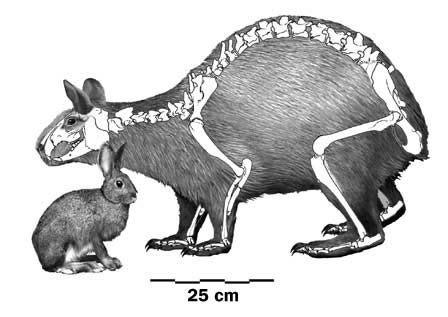Paleontologist Josep Quintana Cardona of the Mediterranean island of Minorca and colleagues have discovered the fossils of the largest rabbit that ever lived on Earth:
The new hunk of a rabbit, now named Nuralagus rex, shows the kind of unusual turn that evolution can take on islands. “Gigantism happens,” explains Brian Kraatz of Western University of Health Sciences in Pomona, Calif. When pioneer animals start colonizing an island, rates of evolution typically speed up at first, he explains. Small creatures can supersize, and big ones can shrink. [...]
So far no plausible rabbit-eaters have turned up among fossils from the same stretch of time on Minorca, so the big bunnies could have evolved larger and larger body size without pressure to maintain speed and agility to escape predators. The relatively short, stiff spine of the fossils suggests that Nuralagus didn’t hop much, if at all, say Quintana Cardona and colleagues. They describe its pace as “low-gear walking.” [...]
What the rabbit king of Minorca did have were paws adapted for digging, a help in finding food to sustain its regal size. So far, though, there’s no sign of giant carrots.


No comments:
Post a Comment